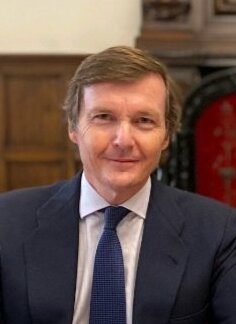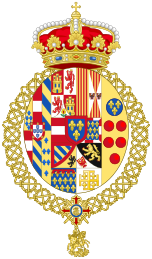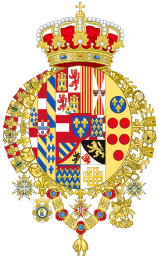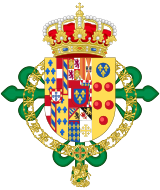Prince Pedro, Duke of Calabria facts for kids
Quick facts for kids Prince Pedro |
|||||
|---|---|---|---|---|---|
| Duke of Calabria Count of Caserta |
|||||
 |
|||||
| Head of the House of Bourbon-Two Sicilies (disputed) | |||||
| Tenure | 5 October 2015 – present | ||||
| Predecessor | Infante Carlos | ||||
| Heir | Prince Jaime | ||||
| Born | 16 October 1968 Madrid, Spain |
||||
| Spouse |
Sofía Landaluce y Melgarejo
(m. 2001) |
||||
| Issue | Prince Jaime, Duke of Noto Prince Juan Prince Pablo Prince Pedro Princess Sofía Princess Blanca Princess María |
||||
|
|||||
| House | Bourbon-Two Sicilies | ||||
| Father | Infante Carlos, Duke of Calabria | ||||
| Mother | Princess Anne of Orléans | ||||
| Religion | Roman Catholic | ||||
Prince Pedro of Bourbon-Two Sicilies, Duke of Calabria, Grandee of Spain was born on October 16, 1968. His full name is Pedro Juan María Alejo Saturnino de Todos los Santos. He is the only son of Infante Carlos, Duke of Calabria, and Princess Anne of Orléans. Prince Pedro is considered by some to be the main leader of the Royal House of Bourbon-Two Sicilies. This royal family once ruled the Kingdom of the Two Sicilies before Italy became a united country.
Contents
Who is Prince Pedro?
Prince Pedro is the only son of Infante Carlos, Duke of Calabria (who lived from 1938 to 2015) and Princess Anne of Orléans. After his father passed away on October 5, 2015, Pedro became one of two people who claim to be the head of the House of Bourbon-Two Sicilies. The other person making this claim is Prince Carlo, Duke of Castro.
Prince Pedro also claims to be the Grand Master of several important orders. These include the Sacred Military Constantinian Order of Saint George and the Order of Saint Januarius. He is also the president of the council for four Spanish Military Orders: Santiago, Calatrava, Alcántara, and Montesa. Because his father was an infante of Spain, Prince Pedro is also a grandee of Spain.
The Act of Cannes (1900)
There is a long-standing discussion about who should lead the House of Bourbon-Two Sicilies. This discussion often refers to an agreement made on December 14, 1900, called the Act of Cannes. In this agreement, Prince Carlos of Bourbon-Two Sicilies signed a document. He was the next oldest brother to Prince Ferdinando Pio, Duke of Castro, who was the head of the Bourbon-Two Sicilies family at the time.
Prince Carlos signed this document before he married María de las Mercedes, Princess of Asturias. She was expected to become the Queen of Spain. The agreement stated that Prince Carlos would give up his "future succession" rights to the former crown of the Two Sicilies. This was done to follow an old rule from 1759, set by Charles III of Spain. This rule said that the thrones of Spain and Naples should never be held by the same person.
The Act of Cannes stated that Prince Carlos was giving up his rights to the crown and royal family assets. He did this for himself and his future children. This was done to follow the 1759 rule.
However, there are different views on this agreement.
Different Views on the Claim
Supporters of Prince Carlo, Duke of Castro, argue that because Prince Carlos signed the Act of Cannes, he and his descendants gave up all their rights. This would mean that Prince Carlo should be the head of the family and the leader of the Sacred Military Constantinian Order of Saint George.
But supporters of Prince Pedro, often called "legitimists," disagree. They say that the Act of Cannes had a condition that was never met. They believe the agreement would only apply if Prince Carlos's wife had become Queen of Spain and he had become King of the Two Sicilies. This never happened. They also point out that the Act of Cannes did not specifically mention giving up the leadership of the House of Bourbon-Two Sicilies or the Constantinian Order.
Many experts agree that the leadership of the Constantinian Order is not tied to ruling a country. It is seen as a separate family inheritance. This means that even if the throne was given up, the leadership of the Constantinian Order would still belong to Prince Pedro.
Prince Pedro's Career
Prince Pedro studied and became an agricultural engineer. He graduated from the University of Castilla–La Mancha. He also completed his military service in the Royal Guard in Spain.
Today, he manages his family's large estate called La Toledana in Ciudad Real, Spain. He also oversees other family properties in Spain and Austria.
Family Life
Prince Pedro married Sofía Landaluce y Melgarejo on March 30, 2001. Sofía was born on November 23, 1973, in Madrid. Her parents are José Manuel Landaluce y Domínguez and María de las Nieves Blanca Melgarejo y González.
Pedro and Sofía have seven children:
- Prince Jaime of Bourbon-Two Sicilies was born on June 26, 1992, in Madrid. He is known as the Duke of Noto. He married Lady Charlotte Diana Lindesay-Bethune on September 25, 2021. They have one daughter:
- Princess Francesca Sofía of Bourbon-Two Sicilies, born on October 13, 2023, in London.
- Prince Juan of Bourbon-Two Sicilies was born on April 18, 2003, in Madrid.
- Prince Pablo of Bourbon-Two Sicilies was born on June 26, 2004, in Madrid.
- Prince Pedro of Bourbon-Two Sicilies was born on January 3, 2007, in Ciudad Real.
- Princess Sofía of Bourbon-Two Sicilies was born on November 12, 2008, in Madrid.
- Princess Blanca of Bourbon-Two Sicilies was born on April 7, 2011, in Ciudad Real.
- Princess María of Bourbon-Two Sicilies was born on March 5, 2015, in Ciudad Real.
Honours and Awards
Prince Pedro has received several honours and awards throughout his life.
Family Honours
 : House of Bourbon-Two Sicilies: Knight Grand Cross of Justice of the Sacred Military Constantinian Order of Saint George (1986–2015)
: House of Bourbon-Two Sicilies: Knight Grand Cross of Justice of the Sacred Military Constantinian Order of Saint George (1986–2015) : House of Bourbon-Two Sicilies: Sovereign and Grand Master of the Illustrious Royal Order of Saint Januarius
: House of Bourbon-Two Sicilies: Sovereign and Grand Master of the Illustrious Royal Order of Saint Januarius : House of Bourbon-Two Sicilies: Sovereign and Grand Master of the Sacred Military Constantinian Order of Saint George
: House of Bourbon-Two Sicilies: Sovereign and Grand Master of the Sacred Military Constantinian Order of Saint George : House of Bourbon-Two Sicilies: Sovereign and Grand Master of the Order of Saint Ferdinand and of Merit
: House of Bourbon-Two Sicilies: Sovereign and Grand Master of the Order of Saint Ferdinand and of Merit : House of Bourbon-Two Sicilies: Sovereign and Grand Master of the Royal Order of the Two-Sicilies
: House of Bourbon-Two Sicilies: Sovereign and Grand Master of the Royal Order of the Two-Sicilies
National Honours
 Sovereign Military Order of Malta: Bailiff Grand Cross of Honour and Devotion of the Sovereign Military Order of Malta
Sovereign Military Order of Malta: Bailiff Grand Cross of Honour and Devotion of the Sovereign Military Order of Malta Vatican: Knight Grand Cross of the Equestrian Order of the Holy Sepulchre of Jerusalem
Vatican: Knight Grand Cross of the Equestrian Order of the Holy Sepulchre of Jerusalem Spain: Commander of the Civil Order of Alfonso X the Wise (awarded on December 22, 2017)
Spain: Commander of the Civil Order of Alfonso X the Wise (awarded on December 22, 2017)
Other Activities
Prince Pedro is involved in several other important activities:
- He is the President of the Foundation for the Protection of Nature.
- He is the President of the Foundation Lux Hispaniarum.
- He is the President of the Foundation of the Hospital of Santiago de Cuenca.
- He is a Patron of the Foundation of Commanderies of Santiago.
- He is the Vice-President of the Delegation of the Community of Castilla-La Mancha of the APD.
Images for kids
- Heraldry of Prince Pedro of Bourbon-Two Sicilies
See also
 In Spanish: Pedro de Borbón-Dos Sicilias y Orleans para niños
In Spanish: Pedro de Borbón-Dos Sicilias y Orleans para niños




